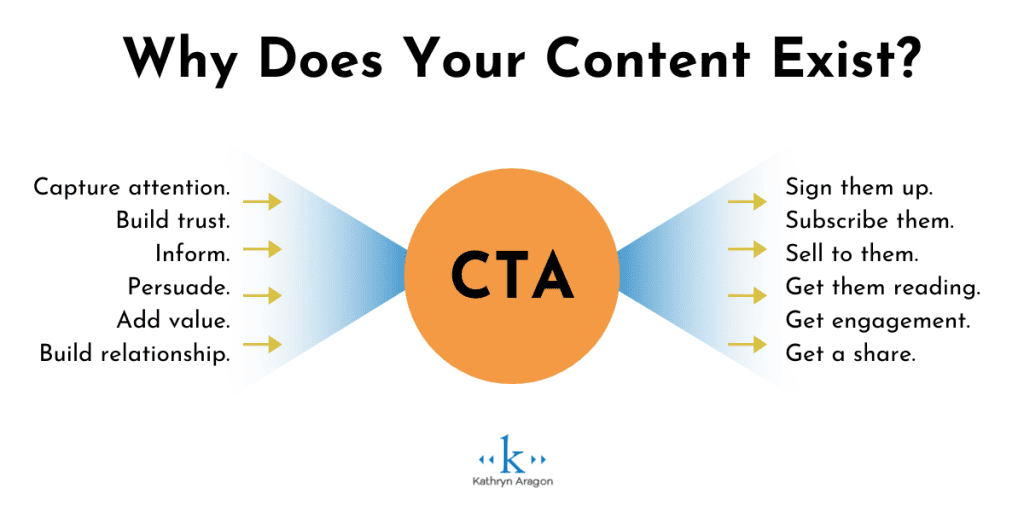One of my favorite things in marketing is the CTA.
The CTA is the bottom line. It’s why every piece of marketing exists. Whether it’s a blog post, a LinkedIn post, a landing page, or an ebook, if it’s a legitimate marketing piece, it has a purpose for being, which is stated clearly and concisely in the CTA.
Or it should.
In recent years, a lot has changed in revenue organizations. There’s a lot of focus on “modern” methods, which basically means we’ve recognized the need (finally) to be human and ethical.
Good call. I don’t disagree.
But in many cases, this shift to being human has changed our priorities. It put the focus on who you know, how many likes you earn, how many shares you get, and other vanity metrics.
Now, don’t get me wrong. I’m actually a proponent of modern marketing. I was denouncing smarmy marketing long before that banner was picked up by bigger brands.
As a copywriter in the financial industry, I learned how to drive action without being pushy, to earn trust and likes without being bombastic. A lower key, relationship-based style of marketing suits me to a T.
The problem I see today is the focus on tactics and channels above the one thing that matters most, and that’s revenue.
Create (Less) Content
For years, I’ve decried the emphasis on content for content’s sake. Thankfully, other content creators agree with me now. I’m hearing less and less that content is king. But it’s a siren call that’s hard to resist…
Create bigger content. Creating better content. Create more… More… More…
Over the last decade, there’s been such a focus on content creation — the messaging, the formats, the media — that we’ve forgotten our purpose for being.
Which brings me back to the lowly CTA.
The call to action (CTA) is where it’s at. It’s the reason your article or video or book exists in the first place. It’s the focal point. Everything else leads up to or takes off from the CTA.

The CTA is your reminder that every piece of content must have a purpose. It needs to serve your target audience and your business.
Your content can drive traffic, boost subscriptions, and create fans. All of these are business objectives. Good. That’s half the equation.
The other half is to reward your audience for giving you their time and attention. You need to give them useful information, help them solve a problem, give them confidence that they’re making the right decision.
To create this type of content, you have to get inside the user’s head and the CFO’s head. Both.
As content creators, we’ve been so focused on quality, we aim merely to entertain, inform, or persuade. If we tick those boxes, our content succeeds, right?
But ultimately, it needs to help you capture attention, build trust, inform, and draw your audience deeper into the funnel. Ultimately, it exists to help drive sales.
The Solution Isn’t What You Think It Is
A decade ago, when content marketing came into vogue, businesses far and wide were told, Create content. The more the better. Create content and you’ll attract visitors and sell more.
Once blog content failed to deliver, we started creating other types of content. We churned out social content, audio content, video content, live content, and more.
Today, the world is over-full of content: fluffy content, badly produced content, content that doesn’t say anything or serve any purpose.
In case you’re wondering, creating better content isn’t the solution. Distributing content better isn’t the answer either.
Creating no content… well… that’s just silly. You’re a business, after all. You need to get your message in front of your audience.
And that, my friends, is my point. Not content for content’s sake. Not a particular format of content. Not a particular distribution channel.
All that matters is the right message, put in front of the right people, driving them to take the right actions.
What matters is that you do marketing the way it was always intended to be done. The basics still work. And they always will.
Which is why I love the CTA.
Content drives your marketing, but it needs to be purposeful. Before you start researching or writing your next marketing piece, make sure you know what you’re trying to accomplish and why.
What about you? Do you find yourself tempted to constantly create bigger… better… more content?
Would you like to get more no-nonsense marketing goodness like this article?


